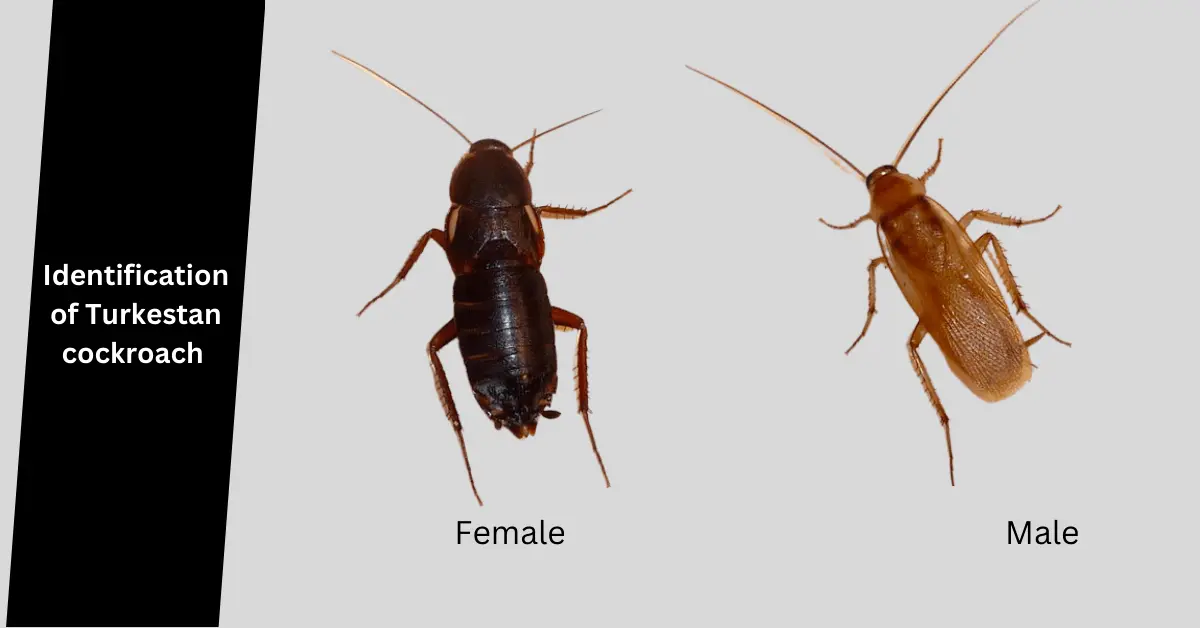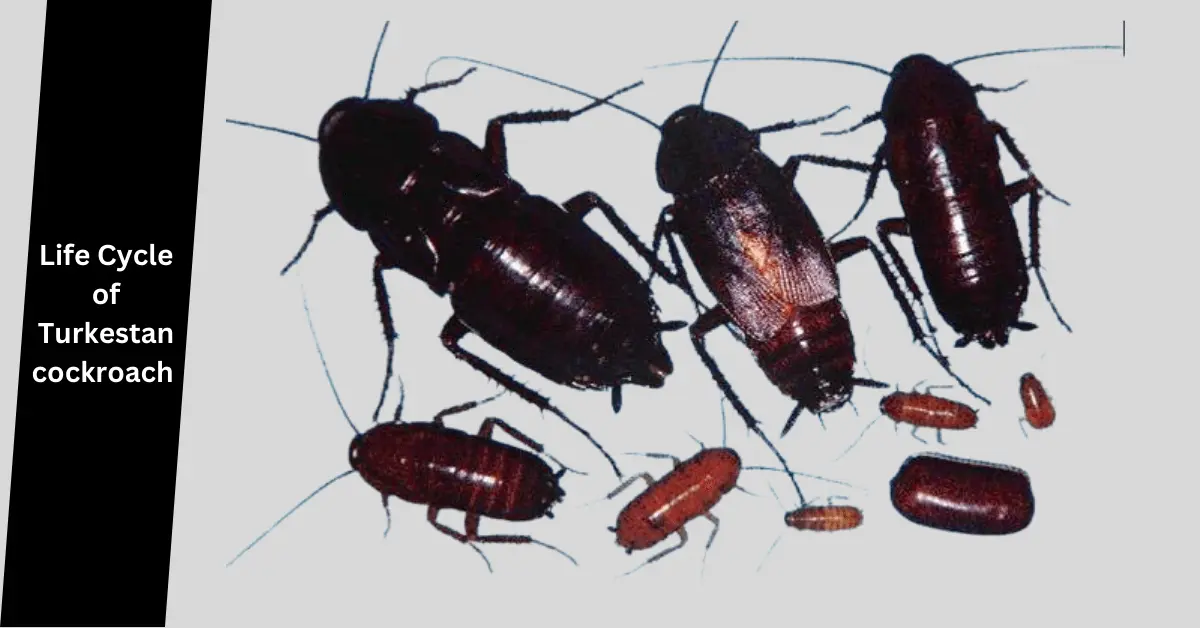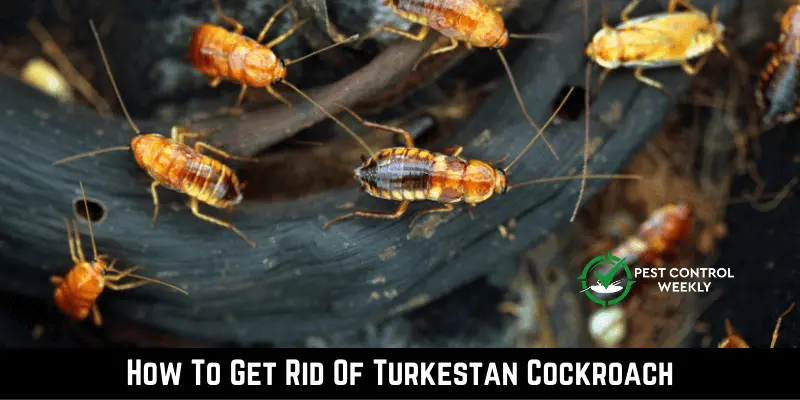Turkestan cockroaches are a problem for many homes and businesses, and it can be hard to get rid of them once they are there. These cockroaches are known for being tough and able to change with their surroundings. This makes them hard to get rid of. So the question is how to get rid of Turkestan cockroaches.
Here are some ways to get rid of Turkestan cockroaches:
- Sanitation
- Chemical control
- Baits
- Traps
- Insecticide sprays
- Residual insecticides
- Dust
- Boric acid
- Temprid SC
This article will show you how to get rid of Turkestan cockroaches from your home or business. We will talk about both chemical and nonchemical ways to get rid of pests and keep them from coming back in the future.
Origin of Turkestan Cockroach
According to the Journal of Economic Entomology, the Turkestan cockroach lives in Uzbekistan, Kazakhstan, and Turkmenistan, which are all in Central Asia. It is thought that the cockroach came to North America in the early 1970s. Military equipment from the Middle East likely brought them there.
Since being brought to the United States, the Turkestan cockroach has quickly spread across the southwest and can now be found in many other parts of the country.
This type of cockroach can live and do well in both indoor and outdoor settings, and if left alone, it can quickly grow into a large population. Turkestan cockroaches aren’t considered a major threat to public health, they can still be a problem for homes and businesses.
Habitat Of Turkestan Cockroach
Turkestan cockroaches are adaptable insects that can live in many different types of environments. They like warm, dry climates best but can also live in cooler places. In their natural habitat, Turkestan cockroaches live in places like fields, gardens, and agricultural areas.

Turkestan cockroaches are usually found in landscaped areas near buildings and homes in cities. They can also be found in sewers, garbage areas, and other places with much water and organic matter.
Turkestan cockroaches usually live in warm, damp places inside homes, like kitchens, bathrooms, and laundry rooms. Overall, Turkestan cockroaches are flexible and can live in various places. This makes them hard to get rid of.
Life Cycle Of Turkestan Cockroach
The life cycle of a Turkestan cockroach has three stages: egg, nymph, and adult. The whole process takes between 6 and 12 months, depending on the temperature and how much food and water are available.

| Egg Stage | The female Turkestan cockroach lays eggs in an ootheca protective case. The ootheca holds about 24 to 28 eggs and is dropped or stuck to a surface where it is safe from predators and gives the eggs the humidity and warmth they need to grow. |
| Nymph Stage | When the eggs hatch, they turn into nymphs like baby cockroaches but don’t have wings. As they get bigger, nymphs go through a process called “molting,” in which they shed their skin. The number of molts can change based on the weather and available food and water. |
| Adult Stage | When the nymph completes its last molt, it transforms into an adult Turkestan cockroach. Adult cockroaches have wings and can make more of their kind. A Turkestan cockroach’s life span can vary based on its environment, but it usually lasts between 6 and 12 months. |
It’s important to know that the time it takes a Turkestan cockroach to go through its life cycle depends on the temperature, humidity, and availability of food and water.
Diet And Behavior Of Turkestan Roaches
Turkestan cockroaches are omnivores that will eat almost anything they can find. They like starchy and sweet foods best but will also eat meat, fruits, and veggies. They especially like fermenting foods and are often found where alcohol has been spilled, or fruit has gone bad.
Turkestan cockroaches are most active at night. During the day, they like to hide in cracks and crevices. They are known to be fast runners who can move quickly if they feel threatened. They can also climb and get up smooth surfaces with ease.
These are social insects that live in big groups. They talk to each other by giving off pheromones, which they do through their poop and other bodily fluids. If you don’t stop them, these pheromones can bring more cockroaches to the same place, leading to a big problem.
Signs Of Turkestan Cockroaches Infestation
Signs of an infestation of Turkestan cockroaches may include:
| Seeing Live Cockroaches | Turkestan cockroaches are active at night, so seeing them during the day can be a sign of a roach infestation. |
| Finding Dead Cockroaches | If you find dead cockroaches in places where they like to hide, like behind appliances or in cabinets, it could mean there are more of them than you thought. |
| Cockroach Faeces | Cockroach feces are small and dark, and you can find them where cockroaches hide or eat. They might look like tiny black or brown spots. |
| Bad Smell | Turkestan cockroaches give off a musty, unpleasant smell that can be especially strong in places with many of them. |
| Damage To Materials | In their search for food, Turkestan cockroaches can damage things like paper, clothing, and packaging. |
| Oothecae | Cockroach egg cases, called oothecae, can be a sign that cockroaches are breeding in the area. |
[8] Ways To Get Rid Of Turkestan Cockroach
Sanitation
Sanitation is a key part of any plan to get rid of pests, especially Turkestan cockroaches. Here are some ways that good sanitation can help get rid of these pests:
- Clean up food spills and crumbs. Turkestan cockroaches are attracted to food, so it’s important to keep your kitchen and other places where you eat clean and free of food debris.
- Store food in airtight containers. Cockroaches can get into food that is stored in cardboard boxes or open containers. Use containers that don’t let air in and keep them off the floor to store food.
- Keep trash in sealed containers and get rid of it regularly.
- Clean up the mess.
- Seal cracks and holes in walls, windows, and doors that cockroaches could use to get into your home.
- Cockroaches need water to live, so fix any leaky faucets or pipes that could give them a moisture source.
- Regularly vacuuming your home can help get rid of cockroach eggs, nymphs, and adults.
Keeping things clean can make the environment less appealing to Turkestan cockroaches and help stop them from taking over. If there are a lot of pests, you may need to hire a professional to help you get rid of them.
Chemical Control
Many typical insecticides don’t work on Turkestan cockroaches. This makes it hard to get rid of them with chemicals alone. But there are some chemical ways to control them that can work to reduce their numbers:
- Insecticide sprays: There are several insecticide sprays available that are labeled for use against cockroaches, such as pyrethroids and neonicotinoids.
- Baits: Baits for cockroaches can be used to eliminate Turkestan cockroaches. Baits have slow-acting poisons that are attractive to cockroaches.
When using insecticides, it is important to read and follow the instructions carefully and to take the right safety precautions.
Use of Baits
A great way to get rid of Turkestan cockroaches is to use bait. Here are some tips for getting rid of Turkestan cockroaches by using baits:
- Choose the right bait. There are many baits for cockroaches on the market, but not all of them may work on Turkestan cockroaches.
- Look for baits that say on the label that they can be used on Turkestan cockroaches or more than one type of cockroach.
- Place the bait in the right places. Cockroaches like to hide in dark, damp places.
- Don’t use insecticide sprays together. Cockroaches can be scared away with insecticide sprays, which makes them less likely to take the bait.
- Change the bait often. Over time, cockroach baits can dry out or lose their appeal to cockroaches. Every few weeks or as needed, you should change out the bait.
- Check the infested area regularly to see if the cockroaches eat the bait.
Use of Traps
Traps can be an effective way to catch Turkestan cockroaches and reduce their numbers. Here are some different kinds of traps:
| Glue Traps | Cockroaches get stuck when they walk on the sticky boards that make up glue traps. You can put them along the baseboards or in places where cockroaches tend to go. |
| Bait Traps | Bait traps are like cockroach baits, but they have a sticky substance inside that catches the cockroaches when they try to eat the bait. Bait traps can be set up in places where cockroaches are likely to go. These traps work best for catching single cockroaches. |
| Pheromones Traps | Pheromone traps use chemicals that are made to look like the pheromones that female cockroaches give off to attract males. When male cockroaches are drawn to the pheromone lure, they get stuck on the sticky substance in the traps. Pheromone traps is used to keep track of the number of cockroaches and catch the males. |
Insecticide Sprays
Insecticide sprays can be an effective method for controlling cockroaches in Turkestan. Here are some tips for getting rid of Turkestan cockroaches with insecticide sprays:
- Select the appropriate insecticide. Look for insecticides that say on the label that they can kill Turkestan cockroaches.
- Carefully read and follow the instructions on the label, and make sure you are safe by putting on gloves and a mask when you use the insecticide.
- Apply the insecticide to the right places.
- Don’t spray insecticide in kitchens or places where food is prepared.
- Use a spray bottle with a small tip. You can spray the insecticide directly into cracks and crevices where cockroaches like to hide with a sprayer with a narrow tip.
Residual Insecticides
Turkestan cockroaches are a hardy type of cockroach that can be hard to get rid of with traditional methods. The use of residual insecticides is a good way to get rid of Turkestan cockroaches.
According to the Department of Entomology, University of Kentucky, residual insecticides are pesticides that stay active for a long time, keeping pests away for a long time. People often put them in cracks and crevices, along baseboards, and in other places where insects might hide or move.
Boric Acid
Boric acid can be an effective way to eliminate Turkestan cockroaches, which is also safe. Boric acid is a white powder that you can buy at most hardware stores, drug stores, or online. Here’s how to get rid of Turkestan cockroaches with boric acid:
- Clean your home thoroughly, paying special attention to the kitchen, bathroom, and any damp places where cockroaches might be hiding.
- Mix 3 parts of boric acid with 1 part of a food source, like sugar or flour. This will make the cockroaches want to get into the mixture.
- Place the mixture under sinks, cabinets, or behind appliances where you have seen cockroaches or thought they might be hiding.
- Repeat the process every few days until there are no more cockroaches.
Temprid SC
Temprid SC is a professional-grade insecticide that can stop Turkestan cockroach infestations. It has two active ingredients—imidacloprid and beta-cyfluthrin—that work together to kill pests quickly and keep them away for a long time.
Temprid SC is often sprayed in cracks and crevices along baseboards and behind appliances where cockroaches are likely to move or hide.
When using Temprid SC, it’s important to follow the directions carefully. Temprid SC is a powerful insecticide that can hurt you if you don’t use it correctly. In addition to using Temprid SC, having good hygiene and knowing how to keep pests out of your home is important.
What Are Some Natural Methods For Getting Rid Of Turkestan Cockroaches?
There are several natural ways to get rid of or control Turkestan cockroaches:
Diatomaceous earth
Diatomaceous earth is a natural substance that can eliminate Turkestan cockroaches. Diatomaceous earth is a natural powder made from fossilized algae. It kills cockroaches by drying out their exoskeleton, which makes it hard for them to move.
To use diatomaceous earth, apply a small amount of the powder in places where cockroaches like to hide. It’s important to use diatomaceous earth that is safe for food since other types of diatomaceous earth may contain harmful chemicals.
Essential Oils
Here are some essential oils that may keep Turkestan cockroaches away:
| Peppermint Oil | The pungent smell of peppermint oil bothers cockroaches. Mix a few drops of peppermint oil with water in a spray bottle. Spray the mixture in places where you see cockroaches. |
| Eucalyptus Oil | The strong smell of eucalyptus oil can also keep cockroaches away. Spray eucalyptus oil and water mixture in places where cockroaches are seen. |
| Lavender Oil | Lavender oil has a calming effect on insects and can also keep cockroaches away. Put lavender oil and water in a spray bottle. Use the bottle to spray cockroach-infested areas. |
| Tea Tree Oil | Tea tree oil has properties that kill insects and can help keep cockroaches away. Mix a few drops of tea tree oil with water in a spray bottle, and then spray the mixture in places where you see cockroaches. |
Catnip
Catnip is a herb that has a chemical called nepetalactone in it. This chemical is attractive to cats and can also keep insects away.
Some research shows that catnip can keep some kinds of cockroaches away, like German cockroaches. However, there isn’t much evidence that it can keep Turkestan cockroaches away now.
If you want to eliminate Turkestan cockroaches with catnip, you can put small sachets of dried catnip in places where you’ve seen them.
You can also make a catnip spray by steeping a handful of dried catnip in hot water for several hours, straining it, and diluting it in a spray bottle.
Baking Soda And Sugar
Baking soda and sugar can be used to make cockroach bait that can help get rid of Turkestan cockroaches. The mixture works because it has both the sweet smell of sugar and the alkaline properties of baking soda. When cockroaches eat baking soda, they produce carbon dioxide, which kills them.
Here’s how to make a baking soda-and-sugar bait and how to use it:
- Mix equal amounts of baking soda and sugar in a small bowl.
- Place the mixture in shallow dishes or jar lids in places where you have seen cockroaches.
- Check the bait every day and replace it as needed.
How To Avoid Future Problems With Turkestan Cockroaches Infestation
Here are some ways to prevent future problems with Turkestan cockroach infestations:
| Clean Your House | Since cockroaches like food and water, keeping your home clean and dry can help keep them away. Clean up crumbs and spills regularly, take the trash out often, and fix any leaks or plumbing problems. |
| Seal Entry Points | Turkestan cockroaches can get into your home through small cracks and crevices. Use caulk or weatherstripping to fill gaps around doors, windows, and pipes. |
| Properly Store Food | Open food containers can let cockroaches in, so keep food in airtight containers or the fridge. |
| De-clutter Your House | Cockroaches like to hide in places with a lot of stuff, so keep your home clean and clear of things. This will also make it easier to see if there are any signs of cockroaches. |
| Check Second-Hand Items | Cockroaches can travel on furniture and appliances that have been used before. Before you bring these things into your home, check them out carefully. |
| Use Bug Sprays | Insecticides and traps can help reduce the number of cockroaches, mainly when used as part of a larger plan to eliminate pests. |
| Get Help From A Professional | If you have a lot of cockroaches or they keep coming back, it might be best to call a pest control expert who can give you targeted treatment and tips on how to keep them away. |
Final Thoughts
In conclusion, Turkestan cockroaches can be gotten rid of by taking both preventative and control steps. You can keep these pests out of your home by keeping it clean and dry, sealing openings, and storing food correctly.
You might also be able to get rid of cockroaches with natural remedies like catnip, baking soda sugar, and essential oils. Insecticides and traps can also be used as part of a complete plan to get rid of pests. But it’s important to follow the directions and safely use these products. By following these steps, you can get rid of Turkestan cockroaches and keep your home free of other pests.
FAQs
References
Gaire, Sudip. (2016). Toxicity and repellency of essential oils on the Turkestan cockroach (Blattodea: Blattidae).
Gaire S, Romero A. Comparative Efficacy of Residual Insecticides against the Turkestan Cockroach, Blatta lateralis, (Blattodea: Blattidae) on Different Substrates. Insects. 2020; 11(8):477.
